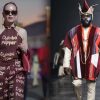Change is a very inevitable part of life. It permeates everything that concerns society from our actions, interactions even down to our tastes. However, in fashion, change is cyclical, it moves from the old to the new and vice versa. For new trends to be pulled up, old trends have to be identified. As we look forward to celebrating the independence day, we look at trends from the era that helped set the foundation of great styles today. Here are a top 5 fashion trends before the Nigerian Independence:
Adire
Adire has had everyone on chokehold since before the 60s. Indigenous to the Western region, Adire is the use of tie and dye with distinctive but stylish patterns. Currently adire has been appropriated to modern attire merging the old trend with the new – a major upgrade.

Heavy wooden shoes
Locally known as the knock-on shoes. As funny as they look, like it or not, these omical-looking and heavy shoes with heavy soles were the in thing in the 60s. Today, we have a myriad of designer footwear – with soft soles, of course- to choose from, while the people back then had shoes to swoon over.

Kitty Heels
The kitty heels bore a singular style: they were either black of white and covered the toes. Inspired by the British ton, they were also lower than what we had today. The Kitty heels were worn by the female socialites of the early 60s. One had to be stupendously wealthy to have a box of one of those babies.
Afro hairstyle
The Afro has remained on the throne of the top Nigerian hairstyles since pre-independence. Relaxers at that time had not made it to the general fashion scene and were reserved for the wealthy. Women and men alike had to make do with their natural hair form. Although Afro has never run out of vogue, it is becoming the trend these days. Fashionistas have taken a liking to adopting a beautiful natural hairstyle and at home with the africanised look. Natural Afro wigs are also being made for people who crave a temporal look.

Maxi skirt
Pre-independence, the typical Nigerian society was classified with a deep-rooted conservatism. This implies that women were expected to be portrayed in a modest yet classy styling leading to the popularization of the maxi skirts. According to records, this elegant ensemble made its way to Nigeria presumably with the Okrika clothing business which involved importing used clothes from Europe.
Several years after Nigeria’s independence, the maxi skirt was reintroduced and paired with sneakers, heels, or sandals; they are now worn for fancy occasions like weddings, church gatherings, office outings, parties.



